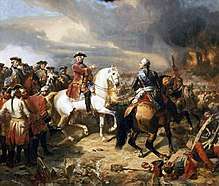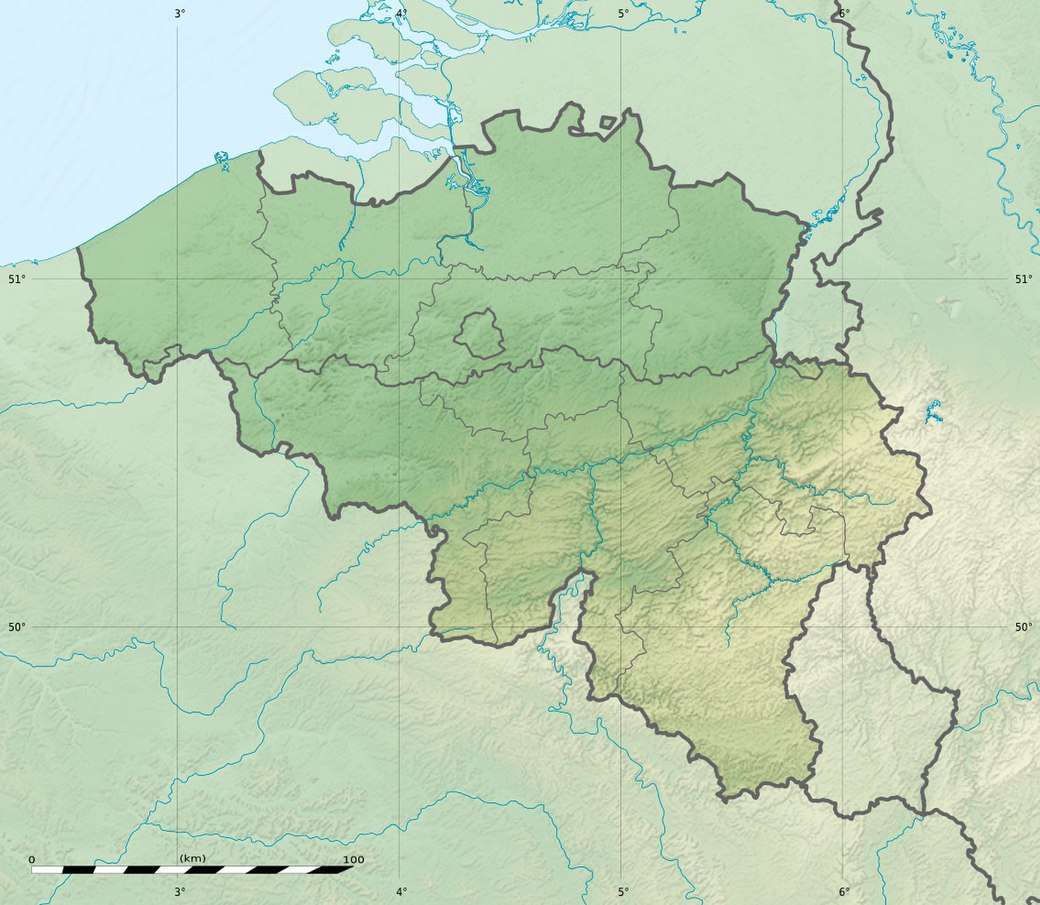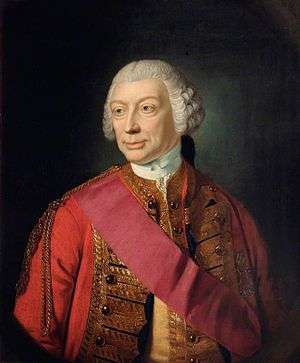Battle of Lauffeld
The Battle of Lauffeld, variously known as Lafelt, Laffeld, Lawfeld, Lawfeldt, Maastricht, or Val, took place on 2 July 1747, between Tongeren in modern Belgium, and the Dutch city of Maastricht. Part of War of the Austrian Succession, a French army force of 80,000 under Marshal Saxe faced a Pragmatic army of 60,000, led by the Duke of Cumberland.
| Battle of Lauffeld | |||||||
|---|---|---|---|---|---|---|---|
| Part of War of the Austrian Succession | |||||||
 Louis XV with Maurice de Saxe at Lauffeld | |||||||
| |||||||
| Belligerents | |||||||
|
|
| ||||||
| Commanders and leaders | |||||||
|
|
| ||||||
| Strength | |||||||
| 60,000 | 80,000 | ||||||
| Casualties and losses | |||||||
| 9,000 dead, wounded and taken prisoner [1] | 8,700 dead and wounded and taken prisoner | ||||||
Under Saxe, arguably the most talented general of his generation, the French had conquered much of the Austrian Netherlands between 1744 to 1746. In the spring of 1747, Cumberland intended to retake Antwerp, but Saxe threatened to cut him off from his key supply base at Maastricht, forcing him to defend it.
Saxe exploited a series of mistakes by Cumberland, and only counterattacks by the Allied cavalry enabled the bulk of his army to withdraw in good order. Defeat ended Allied hopes of regaining lost ground, and the French captured Bergen op Zoom in September, then Maastricht in May 1748.
However, the cost of the war meant France's financial system was on the verge of collapse, while the British naval blockade caused severe food shortages. Their position worsened in October 1747, when the British naval victory of Second Cape Finisterre left them unable to defend their merchant shipping or trade routes. Both sides now wanted peace, leading to the October 1748 Treaty of Aix-la-Chapelle.
Background
When the War of the Austrian Succession began in 1740, Britain was focused on the 1739–1748 War of Jenkins' Ear with Spain, fought mostly in the Caribbean. British and Dutch troops in Flanders initially did so as part of the army of Hanover; France only declared war on Britain in March 1744, the Dutch Republic remained neutral until 1747.[2]

By the end of 1746, most of the participants wanted peace. Having defeated Spanish attacks in Northern Italy, Maria Theresa wanted to focus on rebuilding the Austrian army, and regain Silesia from Prussia. The Austrian Netherlands was acquired in 1713, only because neither the British or Dutch would allow the other to control it; retaining it was not a strategic priority.[3]
French victory at Rocoux in October 1746 confirmed their control of the Austrian Netherlands, but failed to force Britain to end the war. France began the war to reduce the post-1713 expansion in British commercial strength, but by 1747, British trade was expanding once again, while the French economy was being strangled by the naval blockade.[4] Declaring war on the Dutch made the situation worse for both countries, since as neutrals, they had been the main carriers of French imports and exports.[5]
Although the cost of the war also impacted the British, they were far better equipped to finance it.[6] Only British subsidies kept their Allies fighting; in the January 1747 Hague Convention, Britain agreed to fund Austrian and Sardinian forces in Italy and an Allied army of 140,000 in Flanders, increasing to 192,000 in 1748.[7]
Although Franco-British negotiations began at Breda in August 1746, the British envoy, Lord Sandwich, was told to delay.[8] The Duke of Newcastle hoped to recover the Netherlands, and the death of Philip V in July 1746 would break the Bourbon alliance; both proved incorrect.[9]
Battle
By taking troops from other areas, Saxe was able to assemble a field army of 120,000 men for the 1747 campaign. The defeat of the Jacobite Rising allowed Cumberland to transfer troops back to Flanders, and prepare an offensive. He hoped to capture Antwerp in February, but bad weather, lack of transport, and war weariness meant the Allies were not ready to take the field until early May.[10]
During this delay, Contades captured Fort Liefkenhock, making Antwerp too strong to attack. Simultaneously, Löwendahl seized Sas van Gent, IJzenijke and Eekels, threatening Cumberland's supply lines with Maastricht.[11] The latter inspired an Orangist Coup in Zeeland, which eventually led to William IV being appointed first hereditary Stadtholder of all seven Dutch provinces.[12]
To protect Maastricht, Cumberland sent von Daun to secure Tongeren, then held by Clermont-Tonnerre. The Allied cavalry under Ligonier were ordered to occupy the Tongeren-Maastricht road, which ran along a ridge parallel to the River Meuse. Finding the French already in possession, they halted for the night, with the infantry billeted in the villages of Vlytingen and Lauffeld.[13] As at Rocoux, the Austrians were on the right, holding the villages of Grote and Kleine Spouwen, which are now part of the Belgian town of Bilzen. A steep ravine immediately in front protected them from a direct assault.[14]

The next day was overcast, and heavy rain made movement slow and difficult. An exchange of artillery fire began at 6:00 am, which continued until 8:30. The British and German infantry left the villages where they had spent the night, having first set them on fire to prevent their use by the French, and formed up on open ground. Based on his experience at Fontenoy, Ligonier urged they be used as fortified positions; after some hesitation, Cumberland agreed. Saxe assumed the Allies were retreating across the Meuse, and around 10:30 sent troops into what he assumed were now empty villages.[15]
While true of Vlytingen, Lauffeld had been re-occupied by troops under Frederick of Hesse-Kassel, and the next four hours developed into a fierce struggle. The French finally captured Lauffeld around 12:30 pm, after taking heavy casualties in a series of frontal assaults.[15] Cumberland ordered a counter-attack but as the infantry formed up, a Dutch cavalry unit to their front was routed by the French and fled, throwing those behind them into disorder and exposing the Allied centre.[16]
Meanwhile, 150 squadrons of French cavalry had assembled around Wilre, preparing to attack Cumberland's flank; unaware the Allies were falling back on Maastricht, Ligonier and 60 squadrons charged, taking them by surprise. One of the best known cavalry charges in British military history, Saxe later claimed only this prevented him destroying the Allied army. The French Irish Brigade suffered more than 1,400 casualties; at one point, the short-sighted Cumberland mistook the red-coated Irish for his own troops, and barely escaped being taken prisoner.[17]
To cover the retreating infantry, Ligonier obtained permission for another charge, this time with only three regiments. He was taken prisoner, while the Scots Greys, one of the units involved, lost nearly 40% of their strength.[18] This action allowed time for Karl Josef Batthyány and his Austrians to cover the Allied withdrawal.[14]
Aftermath
Lauffeld was another French tactical victory that failed to achieve a decisive result, despite the capture of Bergen-op-Zoom in September and Maastricht in May 1748. The British naval blockade caused a collapse in French customs receipts, and cut them off from the Newfoundland cod fisheries, a key food supply for the poor. Finance Minister Machault repeatedly warned Louis XV of the impending collapse of their financial system.[19]

Despite success in Flanders, the French strategic position became critical after the Royal Navy attacked a large convoy at Cape Finisterre in October 1747. Most of the merchantmen escaped, but at the cost of sacrificing their escort; combined with other losses, the French navy could no longer protect their colonies, or trade routes.[20] In November, Britain and Russia signed a convention for the supply of additional troops and in February 1748, a Russian corps of 37,000 arrived in the Rhineland.[21]
By now, Britain was also ready to agree terms, although it has been argued Newcastle failed to appreciate the impact of the naval blockade. The terms of the Treaty of Aix-la-Chapelle were first agreed by Britain and France at Breda, then presented to their allies. These confirmed Prussian possession of Silesia and minor territorial adjustments in Italy, but essentially returned the situation to 1740, with France withdrawing from the Low Countries. Returning the territorial gains which had cost so much, in exchange for so little, led to the phrase "as stupid as the Peace".[22]
In the longer term, the war confirmed the decline of the Dutch Republic as a major power; Newcastle berated himself for his "ignorance, obstinacy, and credulity", in believing otherwise.[23] British acceptance of the Prussian conquest of Silesia caused the breakdown of the Anglo-Austrian Alliance, and led to Austria's alignment with its traditional enemy France, known as the Diplomatic Revolution.[24]
Lauffeld exposed Cumberland's weaknesses as a general, also factors in the May 1745 defeat at Fontenoy. They included inadequate reconnaissance, lack of strategic awareness, and poor co-ordination with his senior commanders; he failed to inform Ligonier that he had withdrawn the infantry. His career ended following the 1757 Convention of Klosterzeven, when France occupied Hanover; his father, George II, never forgave him.[25]
References
- Grant 2011, p. 421.
- Scott 2015, pp. 48–50.
- Scott 2015, pp. 58–60.
- McKay 1983, pp. 138–140.
- Scott 2015, p. 61.
- Carlos, Neal & Wandschneider 2006, p. 2.
- Hochedlinger 2003, p. 260.
- Rodger 1993, p. 42.
- Scott 2015, p. 62.
- White 2012, p. 207.
- White 2012, p. 208.
- Thompson 2012, p. 177.
- Lauffeldt.
- Morris.
- De Périni 1896, p. 335.
- Smollett 1796, p. 524.
- McGarry 2013, pp. 134–135.
- Oliphant 2015, p. 64.
- McKay 1983, p. 169.
- Black 1999, pp. 97–100.
- Hochedlinger 2003, p. 259.
- McLynn 2008, p. 1.
- Browning 1975, p. 150.
- Ingrao 2000, pp. 157–177.
- Anderson 2000, p. 211.
Sources
- Anderson, Fred (2000). Crucible of War: The Seven Years' War and the Fate of Empire in British North America, 1754–1766. Faber and Faber. ISBN 978-0-571-20535-6.CS1 maint: ref=harv (link)
- Black, Jeremy (1998). America Or Europe?: British Foreign Policy, 1739-63. UCL Press Ltd. ISBN 1-85728-185-3.CS1 maint: ref=harv (link)
- Black, Jeremy (1999). Britain as a Military Power, 1688-1815. Routledge. ISBN 978-1-85728-772-1.CS1 maint: ref=harv (link)
- Browning, Reed (1975). The Duke of Newcastle. Yale University. ISBN 9780300017465.CS1 maint: ref=harv (link)
- Carlos, Ann; Neal, Larry; Wandschneider, Kirsten (2006). "The Origins of National Debt: The Financing and Re-financing of the War of the Spanish Succession". International Economic History Association.CS1 maint: ref=harv (link)
- De Périni, Hardÿ (1896). Batailles françaises; Volume VI. Ernest Flammarion, Paris.CS1 maint: ref=harv (link)
- Grant, RG (editor) (2011). 1001 Battles That Changed the Course of History. Universe Publishing. ISBN 978-0789322333.CS1 maint: extra text: authors list (link) CS1 maint: ref=harv (link)
- Hochedlinger, Michael (2003). Austria's Wars of Emergence, 1683-1797. Routledge. ISBN 978-0582290846.CS1 maint: ref=harv (link)
- Ingrao, Charles (2000). The Habsburg Monarchy, 1618-1815 (New Approaches to European History) (2019 ed.). Cambridge University Press. ISBN 978-1108713337.CS1 maint: ref=harv (link)
- Langford, Paul (1998). A Polite and Commercial People: England 1727-1783. Oxford University Press. ISBN 978-0-19-820733-7.CS1 maint: ref=harv (link)
- McGarry, Stephen (2013). Irish Brigades Abroad: From the Wild Geese to the Napoleonic Wars. History Press. ISBN 978-1845887995.CS1 maint: ref=harv (link)
- McKay, Derek (1983). The Rise of the Great Powers 1648–1815. Routledge. ISBN 978-0582485549.CS1 maint: ref=harv (link)
- McLynn, Frank (2008). 1759: The Year Britain Became Master of the World. Vintage. ISBN 978-0099526391.CS1 maint: ref=harv (link)
- Morris, Graham. "The Battle of Lauffeld". Battlefield Anomalies. Retrieved 8 July 2019.CS1 maint: ref=harv (link)
- Oliphant, John (2015). John Forbes: Scotland, Flanders and the Seven Years' War, 1707–1759. Bloomsbury Academic. ISBN 978-1472511188.CS1 maint: ref=harv (link)
- Rodger, NAM (1993). The Insatiable Earl: A Life of John Montagu, Fourth Earl of Sandwich, 1718-1792. Harper Collins. ISBN 978-0099526391.CS1 maint: ref=harv (link)
- Scott, Hamish (2015). The Birth of a Great Power System, 1740-1815. Routledge. ISBN 978-1138134232.CS1 maint: ref=harv (link)
- Smollett, Tobias (1796). History of England, from the Revolution to the Death of George III: Volume III. T Capel.CS1 maint: ref=harv (link)
- Thompson, Andrew (2012). George II: King and Elector. Yale University Publishing. ISBN 978-0300187779.CS1 maint: ref=harv (link)
- White, Jon Manchip (2012) [1962]. Marshal of France: The Life and Times of Maurice, Comte de Saxe, 1696-1750. Literary Licensing. ISBN 978-1258033590.CS1 maint: ref=harv (link)
- "Battle of Lauffeldt". British Battles. Retrieved 2 July 2019.